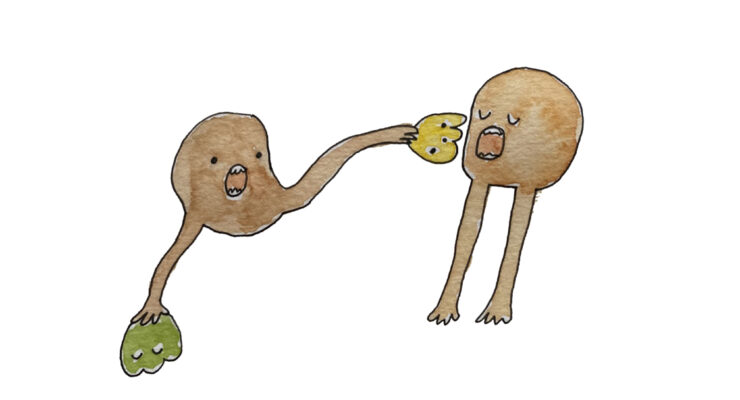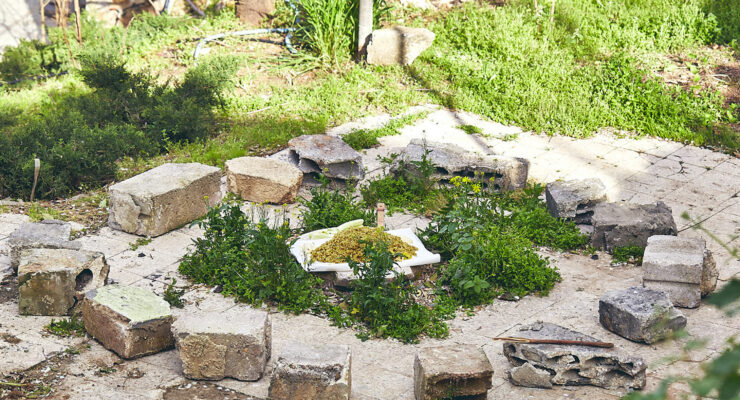“It can be thought of as simply fuel or fetishised for pleasure.”
Steph Marsden enjoys thinking about, writing about and playing with her food. Not only a messy eater, she believes finding fun ways to play with our food (and our perceptions of food) is a great way to learn more about the complex nuances of what we eat, and its relation to culture, the environment and our global food system. Steph studied furniture design and cabinet making and has recently completed an MSc in Gastronomy at Queen Margaret University, Edinburgh. She aims to further examine the connections between gastronomy, art and design through research and creative practice.
What about food and design interests you and why?
Food connects us to culture and the environment. It can be thought of as simply fuel or fetishised for pleasure. It’s complex both in its form; its relationship to our bodies – both physically and psychologically; its journey from pre-production to post-consumption, and in the politics which informs that journey. As a designer, I like to find innovative ways for people to experience and learn about food, possibly in ways they hadn’t thought about before. I’m also interested in projects that connect rural traditions with city dwellers in Scotland. With a background in craft and design, I’m keen to further explore the relationship between Scottish food and heritage crafts.
What position in the food and design field is currently underexposed?
I’m interested in the broad educational potential of Food Design. My interest in food and multisensory design led me to focus my MSc Gastronomy research project on a Food Design event as a case study, in order to critically evaluate the role that artist-led projects may play in engaging members of the public with the complexities of food. Additionally, it’d be nice to see more examples of Food Design which are accessible and not limited to high end or conceptual projects celebrated amongst the design community.
Squid Ink Research Project

Foraged Memories: Fork In The Road Project

How do you see the future of food and design?
Lab-grown meat, 3D printed food, and personalised nutrition?! Personally, I’m not sure many of the current innovations being touted as the future of food are likely to be widespread in the near future, especially when we live in a world where experts can’t agree on what we should be eating as the most healthy, sustainable and culturally appropriate options! I hope the future of food and design will fuse innovation with traditional knowledge to examine, educate and create more interdisciplinary solutions to complex problems within our global food system.
Do you think designers working with food need to address politics and social issues?
Food is so intrinsically connected to society and politics that in these challenging and interesting times, there is certainly plenty of impetus to produce work which examines social and political issues. I believe food can be used as a powerful tool to help share understanding about culture, the global food system and to hopefully encourage a better relationship with our environment and our own humanity. However, it can be tempting for designers to follow trends and I believe, at the core, artists and designers need to do work which really resonates with their own personal values or narratives. Integrity within practice is an important aspect for me.
Can you tell us about the developments in Food and Design in Scotland?
The Scottish food and drink industry is a key component of Scotland’s economy; and we’re revered for the quality of our larder and well known for our whisky, high-quality seafood and meat. However, in Scotland, we suffer from a widely acknowledged paradox: that despite all this great produce we have one of the worst diet-related health records in the developed world. Subsequently, we’re also infamous for our consumption of Irn Bru, Tunnocks Teacakes, Buckfast and deep-fried Mars bars!
Fortunately, Scotland is in a unique position within the UK, with an active network of thriving food communities campaigning and collaborating for a more sustainable food system and food future, and the Scottish government currently consulting on a Good Food Nation bill.
Scotland has a wide array of talented chefs using innovative methods to promote Scottish gastronomy: highlighting biodiversity and local provenance. An example is Edinburgh Food Studio who fuse their restaurant with a research hub and endeavour to keep food interesting by collaborating with guest chefs and interdisciplinary experts such as poets and neuroscientists to create engaging food experiences. The Edinburgh Tool Library has collaborated with artist Morvern Odling to produce Fork In The Road, a creative research project which built an open source design mobile bike to explore the relationships between community and food. Through in Glasgow, the Centre for Contemporary Art operates an open-access public engagement programme and its Cooking Pot programme accepts submissions on a rolling variety of themes that surround food. One such partner, Küche, creates food led events, in collaboration with people navigating the UK immigration system.
Additionally, I also believe it is very important to not overlook the role of small food producers who are making system design changes in the way they operate their businesses. Some of these examples include Mossgiel Farm, Locavore and Stirling Neighbourhood Food – a few of many who are taking innovative steps to change the way food is produced and distributed throughout Scotland.
The future of food in Scotland is especially relevant in light of the current Brexit negotiations, as the UK is currently in a position where it only produces 54% of the food it consumes, while importing twice the value of the food that we export – a ‘food trade deficit’ of $33 billion. This could be seen as either a threat to the food security of the UK or an opportunity for us to operate and reward practices which align with those of food sovereignty. It will be interesting to see how this may be reflected or critiqued in Food Design practices.
—

Read more about Steph’s work on her website: www.foodplayfood.com









